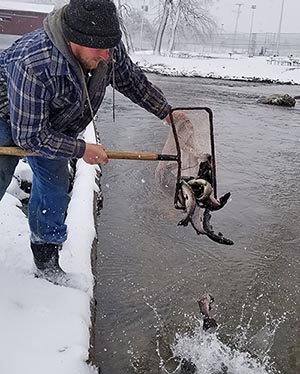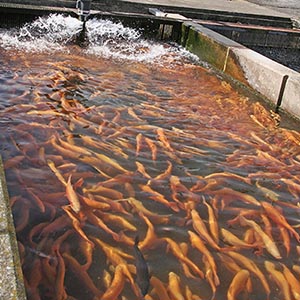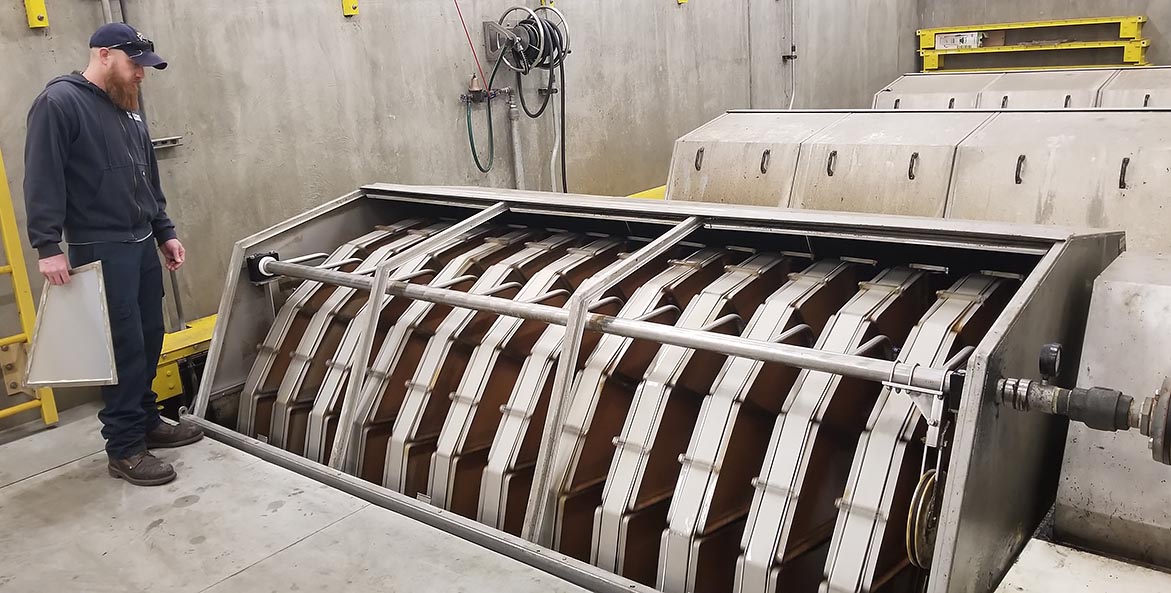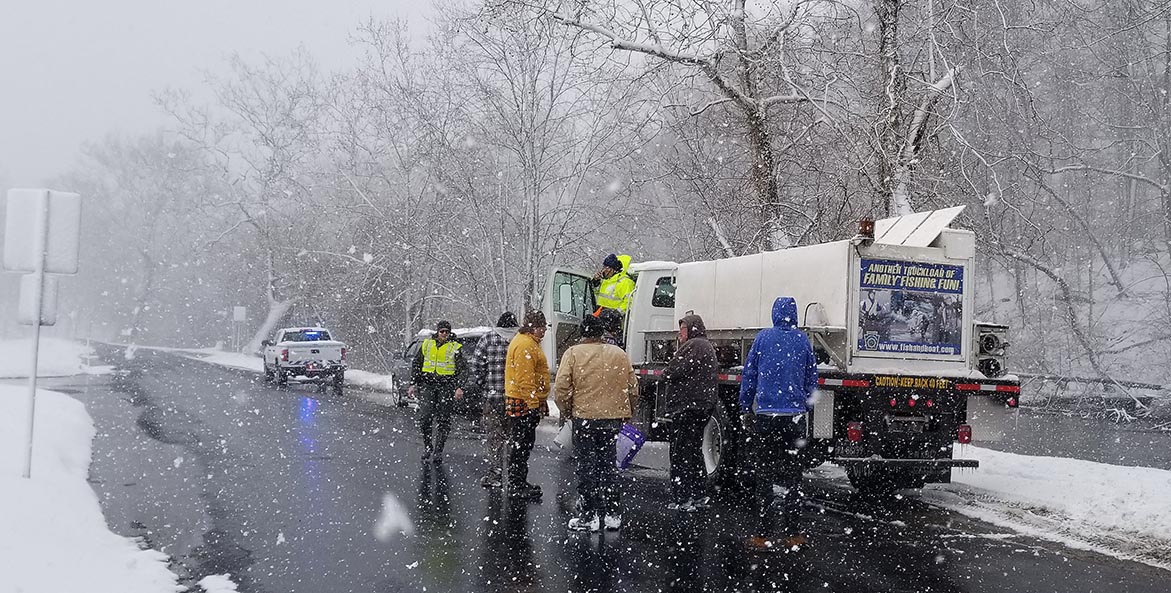Heavy snowflakes appear suspended in the mid-March air as the 14-ton white tanker truck slowly comes to a stop along the Yellow Breeches Creek in Southcentral Pennsylvania. Inside is a precious piscatorial payload of 3,500 trout.
“Your Fishing License Dollars at Work!” announces the back panel of the 25-foot Pennsylvania Fish and Boat Commission trout-stocking truck. It is one of many that will travel almost 300,000 miles to release 3.2 million trout into 4,500 miles of streams and 130 lakes before and after the opening day of trout season, April 1.

On a snowy March day, a volunteer helps release hatchery-raised trout into Yellow Breaches Creek in Southcentral Pennsylvania.
BJ Small/CBF Staff
Most of the fish to come from this truck are 18-month-old, 11-inch trout. There are also stunning golden trout and 20-inch trophy-sized brood fish as old as 3.5 years. At stops like this one and others across the state, a bucket brigade of anxious volunteers is eager to help release them.
Clean Water is Crucial for Hatcheries
Getting 3.2 million hatchery-raised trout into waterways like the Breeches, as well as sustaining wild trout populations, is a critical part of the worldclass fishing for which Pennsylvania’s mountain streams are renowned. Both require good water, and lots of it.
To maintain healthy habitat and waters for wild trout, CBF is working with hundreds of state and local partners on restoration efforts, including major tree planting initiatives like the Keystone 10 Million Trees Partnership and the creation of collaborative, local watershed restoration plans.
Hatcheries, like the Commission’s Huntsdale State Fish Hatchery in Cumberland County, play their own part in achieving the state’s fisheries and clean water goals.

Golden trout awaiting their move to a tanker truck that will take them to their new home in a Pennsylvania stream.
BJ Small/CBF Staff
Huntsdale is one of eight Commission trout hatcheries in the Keystone State. About 7,000 gallons of water from eight or nine springs flow into and out of the hatchery every minute. Spring waters entering Huntsdale’s raceways and hatch house are typically 55 to 60 degrees Fahrenheit, and of variable quality.
The best water flows to the hatch house, where it is used to raise eggs and small trout. The slightly colder water supports brood stock, the adult fish that provide the eggs and milt and then are stocked as trophy fish the following spring.
“They are the future of our fish stocking program and require high quality water,” says Brian Wisner, director of the Commission’s Bureau of Hatcheries.
Huntsdale produces roughly 370,000 pounds of trout each year. About 550,000 fish are adults, and over 250,000 fingerlings (small fish) are delivered to 140 co-operative nurseries.
Clean Hatchery Water Helps Ensure Clean Streams
In addition to water, all of those fish require lots of food—annually, it takes almost 500,000 pounds of feed to raise trout at Huntsdale and 2.5 million pounds for the Commission’s entire trout system. Considering what goes into raising each trout must eventually “come out,” the Commission is concerned about the quality of water that leaves the hatcheries even more so than the water that enters them.
“We do a great job of feeding the fish and capturing the waste products,” Wisner adds.
We want to raise as many fish as we can here for the anglers, but we also don’t want it to be a detriment or impair any of our receiving streams, such as the Yellow Breeches.
Each hatchery has a National Pollutant Discharge Elimination System (NPDES) permit that regulates the water it discharges (called effluent) into waterways. Most hatchery permits limit the total amount of suspended solids in effluent to a monthly average of 3 to 5 milligrams per liter.
“Huntsdale has a great system, typically they are running between 0 and 2 milligrams per liter,” Wisner says.
The Five Stages of Cleaning Hatchery Water
Cleaning the water at Huntsdale starts in small settling basins in each of the 12 raceways where the trout grow and feed. Each raceway is 600 feet long. There are also three 200-foot ponds in each raceway.
The large solids are flushed into a pipe to a clarifier, similar to a septic tank the size of a swimming pool. Clarifiers are emptied every month or two.
Water that flows through the raceways and bypasses the clarifier goes into a large outdoor settling pond. The pond, emptied once a year, is where smaller particles settle and are captured.
After it leaves the settling pond, the water undergoes “final polishing” filtration by passing through rotating discs that contain microscreen filters. Across all hatcheries, “final polishing” has reduced the amount of remaining total suspended solids discharged by another 65 percent.

Hatchery manager Andrew Wagner monitors a filtration pod housing 12 microscreen filters at Huntsdale State Fish Hatchery.
BJ Small/CBF Staff
At Huntsdale, final polishing is accomplished by five pods, each with 12 rotating discs that each hold 16 microscreen filters. Water that leaves the large settling pond is sprayed onto the rotating microscreens. Captured solids are sent to the clarifier.
The filtered water is then pumped into a small tributary of the Yellow Breeches.
“During heaviest time of the year, like before March, we might be feeding 2,000 or 3,000 pounds of actual feed. But what we’ve got coming out of the hatchery is one or two milligrams per liter,” Wisner says. “Depending on which hatchery it is, it might be 50 to 100 pounds a day in tiny, tiny particles and that’s it. That’s not all fish waste. That includes other material that is floating through there too, some from the incoming water.”
Discharged water is sampled one day each week, every hour, for 24 hours.
“We are testing for total suspended solids, ammonia, phosphorus and record the oxygen, the pH, and temperature,” Wagner adds.
The waste is used as fertilizer on agriculture fields. Some farmers and the Commission store waste in sludge tanks for a later application, especially in wintry or wet conditions. Farmers must have nutrient management plans for spreading the waste. The Commission has nutrient management plans for spreading it onto fields on its own properties.
“We take pride in everything that we do here, including cleaning up all of our equipment, including the infrastructure that cleans the water before it leaves. You take pride in that and know that you are not just meeting permit limits,” Wagner says.
“To continue to have pride and know that the water quality is going to be good,” Wagner adds. “We want anglers to know that we are really thinking about that all the time.”
Editor’s note: BJ Small currently serves on the board of commissioners of the Pennsylvania Fish and Boat Commission.




